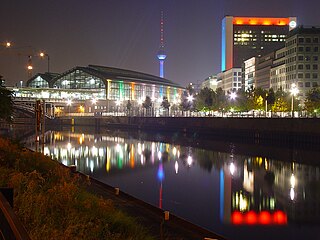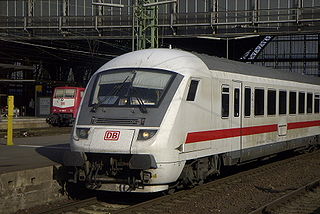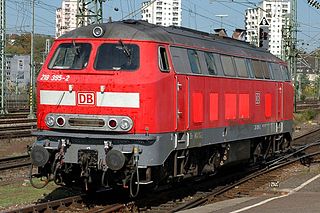
The Berlin S-Bahn is a rapid transit railway system in and around Berlin, the capital city of Germany. It has been in operation under this name since December 1930, having been previously called the special tariff area Berliner Stadt-, Ring- und Vorortbahnen. It complements the Berlin U-Bahn and is the link to many outer-Berlin areas, such as Berlin Brandenburg Airport. As such, the Berlin S-Bahn blends elements of a commuter rail service and a rapid transit system.

The Berliner Verkehrsbetriebe is the main public transport company of Berlin, the capital city of Germany. It manages the city's U-Bahn (underground), tram, bus and ferry networks, but not the S-Bahn urban rail system.
Push–pull is a configuration for locomotive-hauled trains, allowing them to be driven from either end of the train, whether having a locomotive at each end or not.

The Rhine-Ruhr S-Bahn is a polycentric and electrically driven S-bahn network covering the Rhine-Ruhr Metropolitan Region in the German federated state of North Rhine-Westphalia. This includes most of the Ruhr, the Berg cities of Wuppertal and Solingen and parts of the Rhineland. The easternmost city within the S-Bahn Rhine-Ruhr network is Unna, the westernmost city served is Mönchengladbach.

A control car, cab car, control trailer, or driving trailer is a non-powered rail vehicle from which a train can be operated. As dedicated vehicles or regular passenger cars, they have one or two driver compartments with all the controls and gauges required to remotely operate the locomotive, including exterior locomotive equipment such as horns, bells, ploughs, and lights. They also have communications and safety systems such as GSM-R or European Train Control System (ETCS). Control cars enable push-pull operation when located on the end of a train opposite its locomotive by allowing the train to reverse direction at a terminus without moving the locomotive or turning the train around.

Berlin has developed a highly complex transportation infrastructure providing very diverse modes of urban mobility. 979 bridges cross 197 kilometers of innercity waterways, 5,334 kilometres (3,314 mi) of roads run through Berlin, of which 73 kilometres (45 mi) are motorways. Long-distance rail lines connect Berlin with all of the major cities of Germany and with many cities in neighboring European countries. Regional rail lines provide access to the surrounding regions of Brandenburg and to the Baltic Sea.

The DB V 160 locomotive family comprises several classes of closely related 4-axle diesel-hydraulic locomotives built in the 1960s and 1970s for the Deutsche Bundesbahn which take the family name from the earliest built model: the 'DB Class V 160'.

The DRG Class ET 171 was a three-car electric multiple unit built for the S-Bahn Hamburg.

The 485 series is a Japanese limited express electric multiple unit (EMU) type introduced in 1964 by Japanese National Railways (JNR), and subsequently operated by the East Japan Railway Company, West Japan Railway Company (JR-West), and Kyushu Railway Company. Approximately 1,500 vehicles were built, although by April 2016, JR East is the only operator still using this type.

A gangway connection is a flexible connector fitted to the end of a railway coach, enabling passengers to move from one coach to another without danger of falling from the train.

The Wannsee Railway is a suburban railway in Berlin running from Potsdamer Platz via the Ring line station of Schöneberg to Wannsee station on Großer Wannsee, a lake after which it is named. Today it is a section of the Berlin S-Bahn line S1.
The Berlin S-Bahn Train Control System - Zugbeeinflussungssystem S-Bahn Berlin (ZBS) - is a train protection system based on Eurobalises that is designed for the specific requirements of the S-Bahn Berlin rapid transit rail network. It is able to gradually replace the old system based on train stops with overlap safety.

S15 is a planned second north-south route for the Berlin S-Bahn, which will connect Berlin Hauptbahnhof to the Berlin Ringbahn to both north and south. The first section is under construction and is expected to go into operation in 2024.

The DR Class 270 was an electric multiple unit of the Berlin S-Bahn. It was designed for the Deutsche Reichsbahn and was intended to be the replacement for the ageing fleet of S-Bahn units in East Berlin. Test runs were started in 1987 and the first batch was delivered in 1990. After German reunification, Class 270 units were reclassified as DBAG Class 485. A second batch was cancelled in favour of a new design, the DBAG Class 481.

The Berlin S-Bahn began on 8 August 1924 with the first section from Stettiner Vorortbahnhof to Bernau using steam locomotives. On 13 August 1961 it was broken up when the Berlin Wall was built, resulting in two sections: the eastern part and the western part. The western part experienced a massive strike which resulted in closure of several stations, after declining use. Attempts were made to reopen at various times but in the end, only three lines were finally opened after the strike. Since 9 November 1989, when the Berlin Wall was opened, the Berlin S-Bahn began to expand rapidly with their budgetary costs.

The BVG Class 480 is an electric multiple unit for the Berlin S-Bahn. It was originally meant to replace the aging S-Bahn rail cars in West Berlin, but after the reunification of the city, the remaining orders were cancelled and replaced by new orders for DBAG Class 481 cars in 1993.

The DR Class ET 169 was the first class of electric multiple units for use on the Berlin S-Bahn commuter lines. 17 five car units were ordered by the Deutsche Reichsbahn in 1925, each comprising two motor cars with bogies and three short four-wheelers. They were intended for service on the northern lines from Stettiner Station to the rural towns Bernau, Oranienburg and Velten.

Class E was a series of Großprofil multiple units of Berliner Verkehrsbetriebe (BVG) which was exclusively used on East Berlin line E, today line U5 of the Berlin U-Bahn. Except for the two prototypes, all vehicles were built using parts of retired S-Bahn vehicles, namely the bogies and parts of the electrical equipment.

The DR Class ET 168 was the second electric multiple unit that operated on the newly electrified Berlin S-Bahn lines. 17 trainsets in total were ordered by the Deutsche Reichsbahn in 1925 for delivery into the northern suburbs of Berlin.

Deutsche Bahn Classes 483 and 484 are related fleets of electric multiple unit (EMU) trains ordered by German railway operator Deutsche Bahn for use on the Berlin S-Bahn system. They are designed and manufactured by a consortium of Stadler Rail and Siemens Mobility. The first units entered public service on 1 January 2021.


















